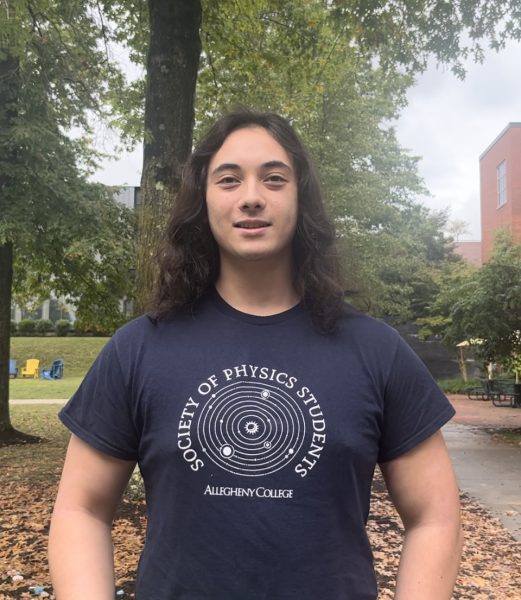‘Hidden Figures’ lecture focuses on Katherine Johnson’s life
Keeping with the spirit of a liberal arts education, Allegheny students gathered last week for a lecture that combined mathematics, space travel and social justice.
Talitha Washington, associate professor of mathematics at Howard University, visited campus Thursday, Feb. 21, in Quigley Auditorium, to lecture about the life and academic contributions of Katherine Johnson, an African-American mathematician who overcame intersectional biases to pioneer breakthroughs in the mathematics of space travel at NASA.
The lecture was hosted by Allegheny’s math department and was structured around the movie “Hidden Figures,” which depicts Johnson’s life through actor Taraji P. Henson.
The movie focuses on Johnson alongside two other African-American mathematicians, Mary Jackson and Dorothy Vaughn, who had to overcome obstacles of racial and sex-based biases on the path to making breakthroughs in orbital mechanics that made astronaut John Glenn’s trip into orbit possible during the Space Race.
Caryn Werner, associate professor of mathematics, introduced Washington with a brief overview of her academic history and accomplishments.
Washington began the lecture by giving some background about the significance of how the movie came into being through the work of author Margot Lee Shetterly, who started writing “Hidden Figures” as a book because she wanted to make stories of African-American women in science more widely known.
“(Shetterly) grew up as a child in a community with a whole bunch of black STEM scholars … but when she became older she realized that their stories really weren’t known,” Washington said. “The Hidden Figures book is actually the first book she’s written, so it’s pretty phenomenal that she would take this leap of faith to write this story and share the lives of these women who made really great impacts at NASA.”
Washington said the first time she saw the movie, it was a deeply emotional experience because she felt it bespoke her own story as a woman of color who wants to be successful in STEM despite the barriers and obstacles of being inherently doubted and underrepresented in STEM fields.
The key problem Johnson encountered was to complete mathematical puzzles necessary for successfully sending Glenn into orbit and then returning him back to earth.
“So one of the things they were talking about in the movie is orbital velocity … and (the question) is how do you change from going in a circular path into a parabolic orbit?” Washington said. “Meaning, if you go around how do you link that to coming back into the earth where you can slow down enough that the acceleration due to gravity will pull you in?”
Washington proceeded to conduct extensive calculations to show the inner dynamics of figuring orbital velocity and explain what areas of math factor into determining them.
“There’s physics when we look at these orbital mechanics, there’s spherical coordinates and a whole bunch of geometry and trigonometry,” Washington said.
To have this play out in “Hidden Figures,” Washington said the producers contracted Rudy Horne, professor of mathematics at Morehouse College, to create the mathematics depicted in the film. Horne had to devise all the math for the movie and the actors had to memorize it for their lines and also learn to draw out equations and graphs on a whiteboard.
Returning to the life of Johnson, Washington explained the immense difficulties faced by a young African-American girl who aspired to get access to an education that would put her on track to make profound contributions to NASA.
“(Johnson) was born in White Sulphur Springs, West Virginia, and her town only had schools for African-Americans up until eighth grade,” Washington said. “So her father picked up the family … and they moved 120 miles so their kids could go to high school.”
Johnson later began attending West Virginia State University, a historically black university, at the age of 15 where she was mentored by William Claytor, the third black person to ever earn a doctoral degree in mathematics, Washington said.
“People would talk about (Claytor’s) thesis and all his good work … and then the conversation would always steer in another direction when they found out his race,” Washington said. “When he was on the job market he only got one offer, from West Virginia State College. So unfortunately for him he only had one opportunity but it was fortunate for (Johnson) because he became her research mentor.”
Johnson quickly exhausted all the mathematics courses the college had to offer, prompting Claytor to develop new courses just for her, Washington said.
Upon graduation, Johnson went into teaching until John Davis, then-president of West Virginia State University, asked her to integrate into graduate studies at the predominately white West Virginia University, Washington said.
Johnson found most of the courses in the graduate program easy due to her former training from Claytor, but eventually had to withdraw after she became pregnant and had to take care of her child. Nonetheless, Washington explained that the spark Claytor lit in Johnson during their time together in undergrad led her to eventually become a research mathematician at NASA.
In 1960, Johnson produced a seminal paper about azimuth angles.
“Essentially the idea is you want to place the satellite over a certain position of the earth after it goes around a certain number of times, what you’re given is the starting position and you know the orbital trajectory of the object,” Washington said. “With this paper, she actually talks about an iterative technique in solving … for the azimuth angle at burnout for placing a satellite over selective earth positions. Burnout essentially means you shut off the rockets … and acceleration due to gravity keeps pulling it around.”
Finding these angles was essential for bringing Glenn safely back to earth, and Johnson and her team eventually cracked the code.
“By doing an iterative calculation you can figure out when to start this burnout,” Washington said. “In her paper (Johnson) has these values.”
In 2017, NASA honored Johnson by naming a research facility after her, and in 2015, she won the Presidential Medal of Freedom, given to her by President Barack Obama.
“(Obama) said ‘if you think your job is hard, (Johnson’s) job meant that if you didn’t carry the one, somebody would end up going out in space,’” Washington said.
In November 2018, Congress unanimously approved the Hidden Figures Congressional Gold Medal Act honoring Johnson, Vaughn, Jackson and Christine Darden for their work at NASA.
Washington said Johnson’s ability to do good, dependable work, even in the midst of the Jim Crow era where many people would make the assumption that someone like her would not be knowable enough, inspires her.
Washington emphasized the relevance Johnson’s story has for African-American STEM scholars, drawing on a few contemporary examples of how they can still face unfounded skepticism, disrespect and must deal with vast gaps in representation within such fields.
“When I hear these stories, they’re painful — why should you have to always be marginalized and discounted for your science?” Washington asked. “But it’s good to hear when people fight back. It’s one of the things that blows my mind … how much talent are we leaving by the wayside when we really have all these various obstacles both known and unknown?”
Washington then brought up Allegheny’s 2020 strategic plan, which encourages diversity and expansion beyond individual borders to make a difference in communities and in the world along with William Jason, Allegheny’s first black alumnus who graduated from the college in 1888. Washington talked about Jason’s career as a pastor and the longest serving president of Delaware State University, all while pursuing a lifelong commitment to education.
“It’s great to see him and see the spirit of Allegheny emanate in what he did,” Washington said.
The lecture, which involved a wide array of unusual combinations, was well received by the audience.
“The lecture was really informative, it was great to learn important ideas of history, diversity and mathematics all coming together into one,” said Luke Fitzgerald, ’20.
Johnson is still alive today. She turned 100 years old last August. Her story will be carried on through the “Hidden Figures” film, book and the lectures of people like Washington.





